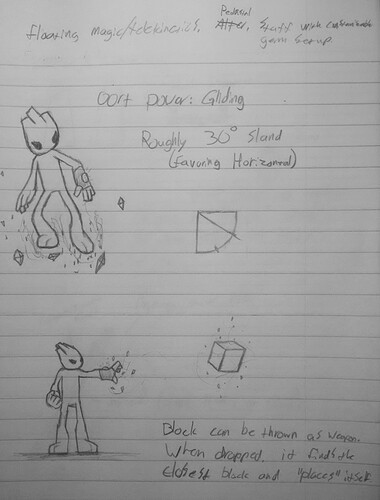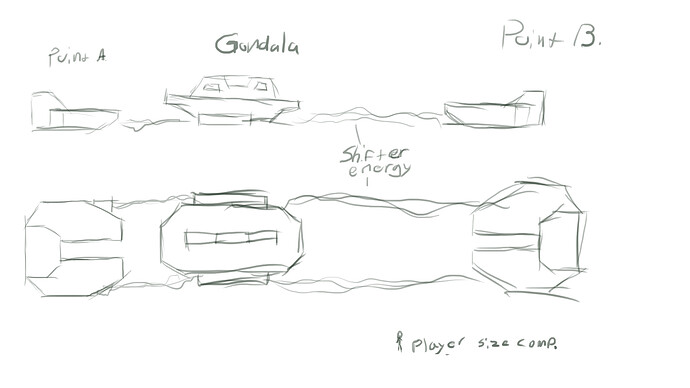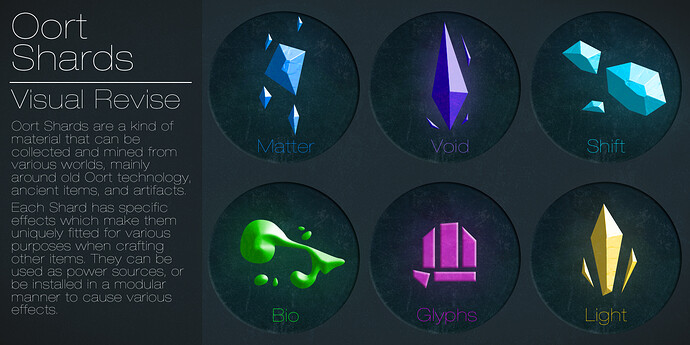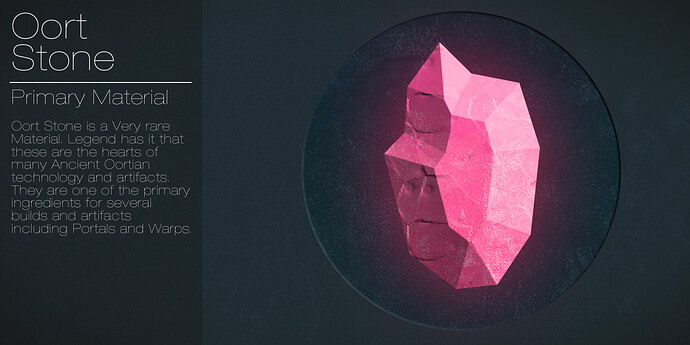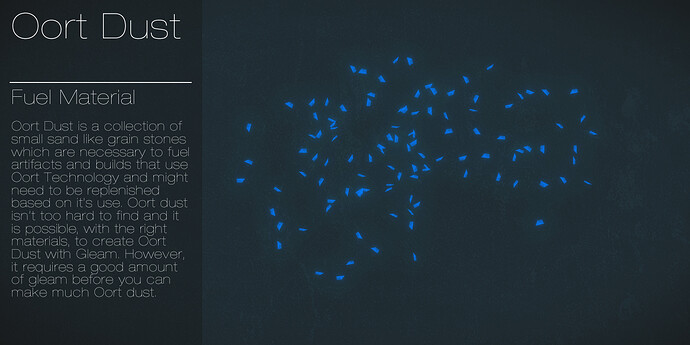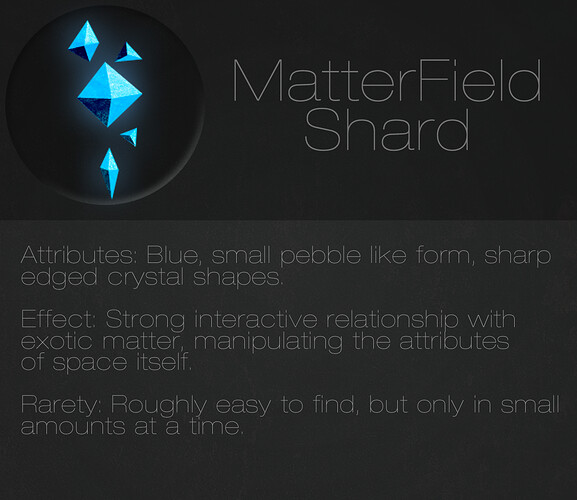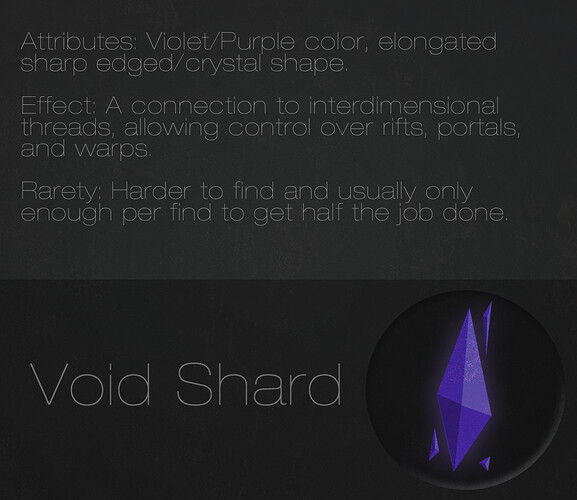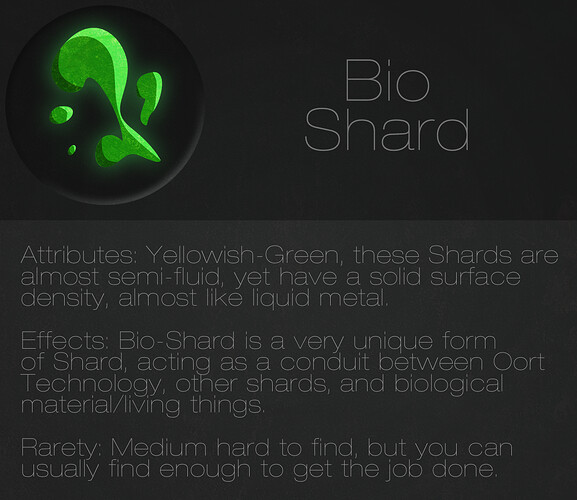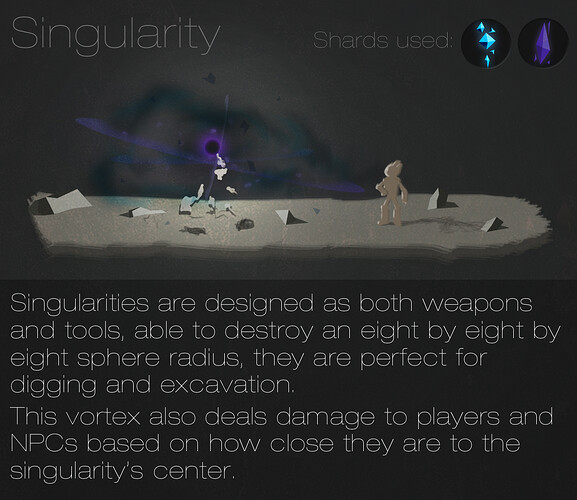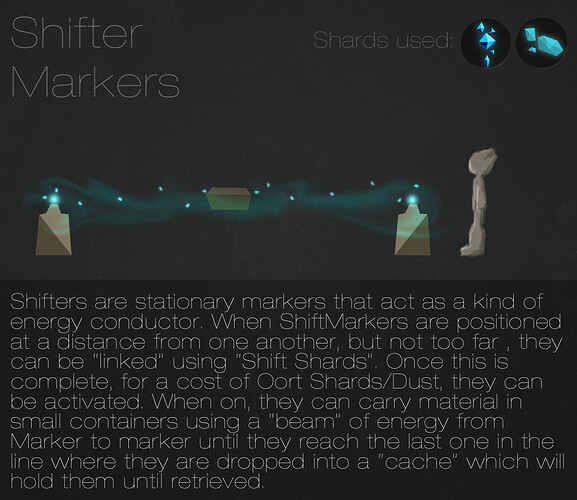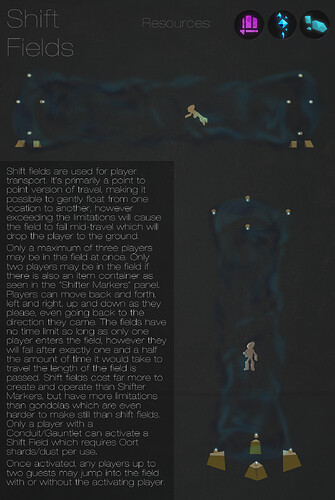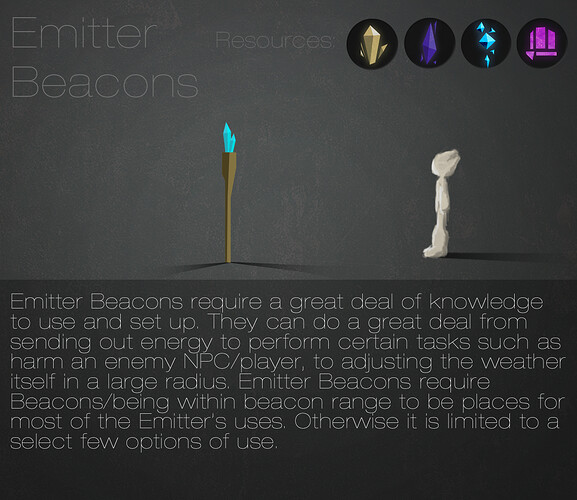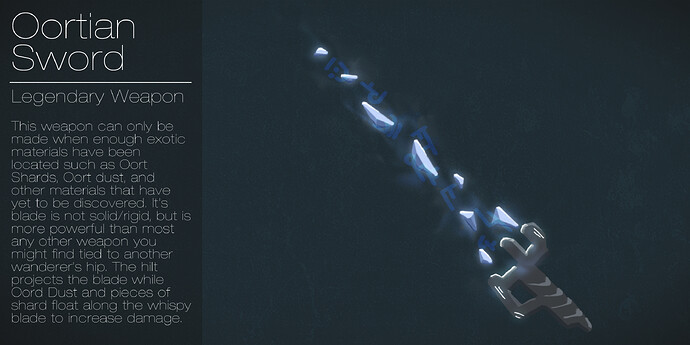I’ve been developing many different types of magic lore over the past several years now and have decided to share the best of my findings with Oort online in hopes they can use it to create something completely new and unique.
Here’s a summary of how the magic system works:
Magic isn’t magic. It’s a highly attuned level of alchemy which influences exotic matter to extreme levels of detail. If one wishes to create fire, one only needs to relay the wish through their power conduit which in turn convinces the exotic matter, or dark matters to create vibrations in the particles of the item you are focusing on. Or if you wish to create ice, you do the same, but the particles are slowed to nullify the energy that causes heat. Conduits are required to generate the effects of “magic”, what they do is link with your nervous system and through it, take the information from your brain to essentially “guess” what you want it to do. Those conduits that are used by one person long enough begins to retain the memory of the person’s intent as it “Attunes” to it’s owner/master. In time not long, the conduit will be nearly incapable of learning the wishes of anyone else, and trying to convert it to your neurological settings would take far more time than starting with a fresh one.
A conduit can be a few things. A chest piece, a pair or singular gauntlet, or even a staff.Creating a conduit requires highly expensive/rare materials and special tools to create, such as a forge. A conduit can be made of most materials, so long as it is lined in some form with Iron. This allows the conduit to “read” you most clearly. For instance, a staff can be made of wood primarily, but it’s Oort shard must be touching Iron which must run down along the staff to make contact with your hands.
When utilized properly over time, a conduit can help you learn how to influence manner different matters. Rather than “dumbing” it down to “elements” however, we will go over how exotic matter’s diversity and endless possibilities make it a fantastic grounds on which to use as magic in this game. Let’s start by explaining why the elements are already something you’d have to learn differently from one another. Dirt and stone can be handled as clots or clumps for instance, generating singularity fields to capture them in a well to lift them or changing the shape of the field they are being held in to influence them into the shape or manner you wish. Water however, is far more tricky. Due to it’s fluidity, it can slip through the field and spill out, this requires us to rethink how the field encases the water. Luckily, Water is a fantastic conductor and also reacts to certain electricity and similar energies. Using this knowledge, we can better seal the water into the shaped field we wish by using more properties to influence it. This means though you can begin using the basic knowledge you already have, you still require new knowledge to influence new materials or “elements”.
Some elements are more complicated, but again rather than forcing the element into a category of it’s own like most typical magic systems, we can use the fact that heat is generated by an energy resulting from friction and atomic vibration. No problem for exotic matter. Though you have to learn how to intricately control the matter to create the vibrations needed [which will be far harder to learn than the difference between dirt and water], it, by the same means of anything else, can be influenced through your conduit.
Now that we’ve got the basics out of the way, it should be rather easy to use theoretical physics to construct the rest of the “spells” you want to use, so be mindful before replying with a wish list of abilities.
Let’s cover some examples of more interesting ways the energies we can create and influence using exotic matters can benefit our Oortciety.
One example of something I heard about not long ago was flight and gliding/hovering.To what rumors have reminded me, I believe this requires Oort dust to fuel a kind of machine. Well I have an idea where by throwing the correct forces about yourself, you can glide down a long distance with a safe landing, however, when you add and use Oort dust/shards, you can even further influence your surroundings by creating upward gravity wells, lifting yourself off the ground and suspending yourself for a short while, however mind the amount of dust/shards you use up, these guys’ energy will be used up and they will fall from your influence in time, so be at the ready with your conduit to glide down safely when you’re all out, or simply don’t glide without enough fuel. This ability could easily be enhanced with the assistance of gliding gear, such as wing mechanisms attached to your back. [Original wing idea courtesy of @b00n, I thought it was actually a very viable idea, dude].
A healing power would also be conducted through means that essentially take material such as food, medicine, or plants and herbs, using the exotic matter, you can deconstruct the items to forms that become immediately absorb-able through the skin or when eaten if the patient is well enough to eat them, or when needed, applied directly to an open wound, then the matter can be used to generate energy that encourages biological materials to work harder and better, giving the body a good boost of healing energy.
One more, self buffs. I had mentioned this once before as well that as you become more attuned with your Conduit, and it you… You can use it to create mini fields of atmospheric adjustments to supply you more oxygen, flow your blood more efficiently, and create small singularities at the tip of your pickax or sword.
Some items need a little more knowledge to construct… Let’s cover artifacts.
Artifacts are creations that use Oort energy and can sometimes operate on their own as more complex constructs. One early example I had thought up was a regeneration/restoration platform. When you stand on this two by two slab height device, it glows from below you, some particles coming up to twirl about your body as your health and energy is restored over time. This method is far superior to the simple healing methods listed above and can cure very severe wounds. However, the more severe your wound, the longer you must remain in this field. You can step out at any time even though you float slightly when in it’s field, but the moment you step off, the healing halts. If you had opened wounds that were not closed before stepping off early, you can still loose health by bleeding out.
Casting artifacts. Yes, I mentioned this exact example before, but you know what? I love snow and want my own snow bioms… Anyhow, let’s say you want an artifact to create a protective bubble/shield, or cause the weather to go cold, or perhaps throw a dangerous bolt of energy at enemy NPCs. Artifacts can be used to generate these effects. When constructed, you focus an ability into it using your conduit as a middle man. Once programmed, an artifact must be placed on a Pedestal to work. To cast an offensive attack, it need only stand within range of the NPC You wish to be struck my it’s automatic bursts. To create a shield, you must fuel it with enough Shards or dust to create a shield big enough, or to last as long as you need it to. Now, changing a biom is tricky. It has to be high, and you must use an Oort stone on it rather than Oort dust so it A. Lasts, and B. Can influence the weather itself in such a radius. When these kinds of artifacts are placed low, their effects do not reach far, and if kept in a room, they do not reach outside that room [If the devs wish to put that much detail into it, at least].
A communication artifact I simply call the “Wanderer” is essentially this: You get in, pick who you wanna talk to, whether it be a friend anywhere on any server, or a random person from your own server. You cannot contact random people in other servers, only friends. Once you have chosen, your abilities are stripped, your body lays dormant in a “Resting” animation while your mind is projected in an almost holographic form near the person you wish to speak to. You can walk, fly, and glide in this form, but nothing else. You can’t even build, break, or attack. All you can do is talk to that person and follow them, lest you travel too far from them and are woken up. When typing, you can be heard by both those around your projection, and those around your actual body in the artifact. It uses Oort Shards per use.
One more kind of artifact worth mentioning is what I like to call a “Well”. This whirling swirl of energy essentially acts as a “Boost” for either artifacts around it, or anyone using Oort powers can draw from it’s ability to collect, store and transmit exotic energy to the owner of the Conduit it was made for/by, and their friends if necessary. It can also empower other items and artifacts like Pedestal artifacts, which when within it’s sphere of influence do not require refills of Oort Shards/Dust or Oort Stones.
Thought I do not know how a lot of these materials would be built, I do know that the more powerful/largely effecting items and constructs will be FAR HARDER to create, making them such a rarity that they are not abused.
Example images and concept sketches.
Gliding and Telekinetics.
Pedestal and Conduits.
The healing slab.
Amendment 1: Repeaters.
Repeaters are a one by one block that stands roughly two/three blocks high. Sometimes, you have a device that is further away from it’s switch, or you need to send a signal to a distant location. These devices are designed to link up in the following manner… Switch/activator linked to repeater one [must be right next to the switch object], repeater one linked to repeater two, repeater two is placed right next to the device. Let’s say you have a house on a hill and a large, tall spire tower with a light, shield, or whatever else kind of artifact or device you might be able to build in the future on top. Rather than build and hook up wires block per block leading up to the light on top, you simply use the repeaters like linked radios to connect the switch in your house to the device in the tall tower.
Amendment 2: Shifters.
Shifters work like the two ends of a gonadal, but with more refined tunability. Place one, then a second. A field/flow of energy will be created between the two when you “link” them. Now place a third and link it with the one in the middle, now you have a curved flow of energy from one destination [block 1[ to another [block 3], with another block letting you curve the energy around a corner or something [block 2]. When you “Use” these items, you must have a “carrier” which is simply a container that is capable of being sent from one end of the stream to the other, in this you place the items you wish to send. A larger version could also be a conceivable idea that allows players with Gauntlets/Conduits of power toss in some Oort Dust and jump in when a gate opens up. This design requires slightly less Oort dust than a warp/portal and can only go a specific distance between gates. It requires two gates be set up so that the sending gate knows where to float the player. Shift gates can be placed both upright for horizontal travel, or flat on the ground for vertical travel, like a super awesome elevator!
The nerf however is travel time, there is a max speed when in these tubed shape tunnels, however you can move back and forth/around the tube’s diameter as much as you want and the gates won’t close until you have reached an exit point. Anything can enter an already opened tube, and yes, combat is very possible when travel in them, so NPCs can jump in and attack you as well as other players. However, a tunnel can only sustain four people at a time… If five jump in, the tube begins to flicker and people begin falling out until only four remain. If six or more jump in, the tunnel destabilizes and shuts down completely. If I forgot to mention, Player shifters can not be linked to more than two gates. Only one at the beginning and one at the destination, none can be supported between.
Another example for the use of Shifters could be a form that rather than carries objects or players, it latches onto a specific conduit attached to a physical block platform, allowing the players to make Gondolas which allow them to place players AND items on by simply hopping on, optionally taking a seat, and placing items into chests aboard the Gondolas.
Amendment 3: Array fields
An Array field is designed specifically for creating a type of energy shield/Barrier. The only thing is you MUST have at least three points in which the barrier is created and you cannot stretch the distance between points too far, lest the field weakens and fails. You can however, make shapes with these points, such as build them onto/into a dome shape to allow air vehicles/creatures to come in and out when the barrier is “Off” or to trap things by turning them on at the base of containers. When de-activates, “points” are non-physical to players and other physics objects, letting you open or enclose large areas.
If utilized properly, it might be possible to lead even some of the smaller protectors into traps, or used to coral animals.
Primary uses however, would morel likely be to protect large areas/openings from outside dangers.
To destory/bring a shield down, a “point” must take enough DIRECT damage to fail, when it fails, it is essentially destroyed, creating a gap in the field simply too big to sustain a shield, creating an opening for intruding/escaping forces to break through. However, this requires some kind of buff such as a weapon and cannot be broken by a player’s bare hands.
Amendment 4: Physics blocks/items
Physics blocks are purely designed to be build for things like gondolas, airships, platforms, etc. They would become extremely useful for players who wish to hand craft machines such as elevators, moving platforms,draw-bridges, and more. Another thing that would go along with this would be rope items. Essentially, let’s say you want to have a draw bridge. You attach a rope to the end of a draw bridge, then to a kind of pulley system at the top of the gate’s opening, then through a wheel system that can turn to draw or let loose the rope, bringing the draw bridge up or down. These ropes would give multiple more uses than this one example.
Another use would be turn-able/motor blocks. These freely spin and would attach physics blocks to the ground or other physics blocks. Alternatively, more advanced versions could be used to build turning/spinning motors. Have a stream nearby? Place one of these blocks by it and place a gear mesh to collect the momentum. By use of gear blocks, you can create an entire mechanical marvel.
Blocks that might come with this kind of idea:
- Steam engine builds: Either meshes or blocks that can be used to generate kinetic forces such as turning an axis.
- Gear blocks: Blocks that let you attach a series of differently sized gears.
- Piston blocks: Push or pull.
- Rope item: Items that let you attach one dynamic thing to another, IE a drawbridge for example.
- Cranks, levers, and wheels: Activation objects that let you control these mechanical marvels.
Possibilities:
- Draw bridges.
- Drive-able vehicles: Might require more than one operator, or the driver to run from crank to wheel, back to another crank, then back to the wheel again. IE: You don’t simply enter the driver seat, you must operate the equipment.
- Gates, large scale chests to hide placed blocks such as storage for building resources/materials.
Amendment 5: Telekinetic detailed
Imagine a small material, something like a small collection of pebbles and dust that sits in a small pouch attached to your belt. When you reach forth with a conduit, one of two things happen. Either you interact with an already Oortian artifact that reacts to your conduit, OR a spread of this small material flows out from your pouch to interact with non-Oortian tech, giving you mild telekinetic abilities. Use this to flip switches, throw chunks of blocks, destroy walls, Interact with physics blocks, etc. [Of course some abilities will require you to possess Oort shards/stone to use and will be limited. Like knocking down entire walls/holes in walls. This material might even be one of the more primary ingredients to gliding as well.
Amendment 6: Oort Stones, Dust, Shards and Shard types
In the spirit of a recent post, I have decided to begin explaining how Oort Shards and Stones would be used based on this lore system. Let’s begin by going over Shards.
Art Upgrade:
Oort Stones:
Oort Dust:
The primary uses for Matter Field Shards would be majorly in combination with other Shards, but would be a VERY Core element in multiple builds.
Void Shards would be far more specific types, using void connection to interact with rifts, warps, and portals. In some cases, these would be used in other contraptions, but are the more dangerous of the Oort Shards.
Shift Shards would be most commonly used in gondola and communications technology to create a synchronization between distant artifacts and contraptions.
Light shards are perfect for imagery and illusion contraptions, but are a little more illusive. They can bend light even if the light does not travel directly through it.
Bioshards are the key to unlocking actual abilities for your character rather than using artifacts and items. This is a KEY ingredient to Conduits.
More to come for Amendment 6 as I go over how other shards come into play and how they each interact with one another as well as what Shards fit best with what machines/artifacts.
Amendment 7: Glyphs
This one I know there was hinted already to be a glyph system, but I thought I’d add it to the list for future reference when I start getting into more detail on contraption construction.
Amendment 8: Artifact construction/Shard use
Shards can be combined to create a varying set of artifacts for a series of different uses! However, most artifacts are not simple constructed of shard alone and will require machines or pre-built devices to attach the shards to to make them operational. Here are some examples.
Singularities last, or are as powerful based on how many shards you use in them: 1 void and 1 matter shard = one half second explosion, dealing minimum damage. 2 void and 1 matter shard = one full seconds of energy and minimum damage which does slightly more since it lasts longer. 1 void and 3 matter shards = three times as much damage for one half second. And so on.
Shift Markers are the material transport system. Store items into a container and send it on it’s marry way! Perfect for sending things over a distance such as between neighboring cities that would otherwise be a bit of a walk, or send things across large canyons rather then spend the time jumping from one side to another.
Shift Fields are more expensive than Shifter Markers, however, cannot have more than two total linked Field emitters. This means the transporting field is only from point A to point B and will go STRAIGHT From one to the other. Curving using midway markers is not possible.
Beacons have a variety of uses, but can be limited based on whether or not they are in a beacon. For instance, they cannot control weather outside of a beacon, but when used to control weather inside a beacon, the entire inside of said beacon is altered.
Oortian Sword.
Amendment 9: Matter Forging
Forging is one of the more ancient methods of construction for tools and weapons known, however what if you wished to forge beyond simple matters like rock, stone, metal, and wood? Matter forging is a VERY specialized method of manipulating energy and matter actively, as to effectively mold something out of energy for whatever use you intend. Matter Forging is accomplished when a Top Tier Conduit of Energy is worn/held, the operator then uses their ability to manipulate matter by embedding glyphs into an item. However, what sets this method apart from other forms of embedding glyphs is that rather than embedding them into an item solely, or onto a wall of sorts, you are also using exotic matters to form the shapes of glyphs in the air which you then attach to the energies around your project to essentially create a self sustaining form of floating matter. These items can only be carried by those with Conduits of energy and cannot be “Grasped” otherwise unless encased into an encasing item for the carrier to hold. Items can be purely Matter Forged and remain this way, or be made for the use of other items.
As an example of an item that is created by way of Matter Forge for the use of being attached to an item of sorts, we will be creating a sword just like the “Oortian Sword” shown above in the Artifacts Amendment. The first thing that must be created is a Hilt. This however, is solid and not purely energy based, however it holds and sustains the energy that forms the blade when in use. The blade must be created using Shards, namely Matterfield and Shift Shards. The Matterfield shards create the force necessary to hold and hover the blade shards in place while the shift shards keep the sword’s parts communicating with one another to make it work as one whole rather than pieces of one whole. The blade would need be made in a Top Tier forge.
Once you have a hilt, you would need to then gather the materials necessary to bring your weapon to life. A Top Tier Conduit of power, and an Oort Stone. You must have an Oort stone on you in order to fully take advantage of Matter Forging. If you have the knowledge necessary and the items required, you can Forge a kind of blade which will act as the core of your blade. Once installed into/onto the hilt, it can then be activated. When active, the blade will stretch out and Shards of Crystal will hover in place. The item we had forged of matter will increase the power and ability of the blade, at the same time it will allow you to have a weapon that will not be destroyed by constant use, instead, you merely need to feed it whatever kind of crystals you use to compose the sword as well as resupply the hilt with Oort Dust. The crystals used to fill the blade must be of some special kind. Shards of gleam for instance could work well with such an item.
I will explain how non-item attached Matter forged items can be used in the next update.
